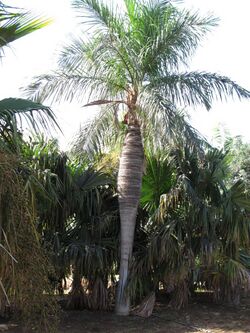Biology:Acrocomia crispa
| Acrocomia crispa | |
|---|---|

| |
| Scientific classification | |
| Kingdom: | Plantae |
| Clade: | Tracheophytes |
| Clade: | Angiosperms |
| Clade: | Monocots |
| Clade: | Commelinids |
| Order: | Arecales |
| Family: | Arecaceae |
| Genus: | Acrocomia |
| Species: | A. crispa
|
| Binomial name | |
| Acrocomia crispa (Kunth) C.F.Baker ex. Becc.
| |
| Synonyms | |
|
Acrocomia armentalis (Morales) L.H. Bailey | |
Acrocomia crispa, the Cuban belly palm or corojo, a palm species which is endemic to Cuba. Formerly placed in its own genus, Gastrococos, recent work found that that genus was nested within Acrocomia.[2] It is a tall, spiny palm with a trunk that is slender at the base, but swollen in the middle, giving it the name "Cuban belly palm" in English.[3]
Description
Acrocomia crispa is a single-stemmed palm tree with pinnately-compound leaves. Stems are 7–18 metres (23–59 ft) tall, with a distinct, "spindle-shaped" bulge halfway up the stem. Trunks are densely spiny, but becomes smooth and grey as the trunk ages. Trees have 10-20 leaves which are up to 3 metres (10 ft) with leaflets which are approximately opposite.[4]
Taxonomy
The species was first described by as Cocos crispa by Carl Sigismund Kunth in 1816 based on an incomplete specimen collected by Alexander von Humboldt and Aimé Bonpland. In 1866 Sebastián Alfredo de Morales described Gastrococcus armentalis based on a distinct type species. Although Morales was able to examine the specimen that Kunth's species was based on, he concluded that the two collections represented different species.[4] In 1912, based on Charles Fuller Baker's description, Odoardo Beccari published a formal description Acrocomia crispa, in which he included Kunth's C. cripsa.[5][4]
References
- ↑ Henderson, Andrew; Gloria Galeano; Rodrigo Bernal (1995). Field Guide to the Palms of the Americas. Princeton, New Jersey: Princeton University Press. ISBN 978-0-691-08537-1.
- ↑ Roncal, Julissa; Scott Zona; Carl E. Lewis (2008). "Molecular Phylogenetic Studies of Caribbean Palms (Arecaceae) and Their Relationships to Biogeography and Conservation". Botanical Review 74 (1): 78–102. doi:10.1007/s12229-008-9005-9.
- ↑ Kyburz, Rolf. "Gastrococos crispa". PACSOA, the Palm and Cycad Society of Australia. http://www.pacsoa.org.au/palms/Gastrococos/crispa.html.
- ↑ 4.0 4.1 4.2 Craft, Paul (2017). The palms of Cuba. Sebastian, Florida. pp. 40–43. ISBN 978-0-6929-7732-3. OCLC 1054275994.
- ↑ Beccari, Odoardo (1912). "The Palms Indigenous to Cuba II". Pomona College Journal of Economic Botany 2: 364. https://www.biodiversitylibrary.org/item/137629#page/172/mode/1up.
Wikidata ☰ Q2711831 entry
 |

